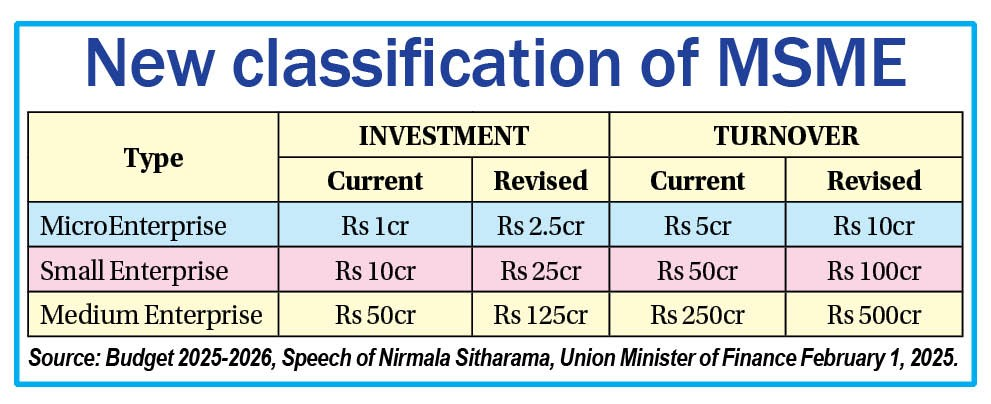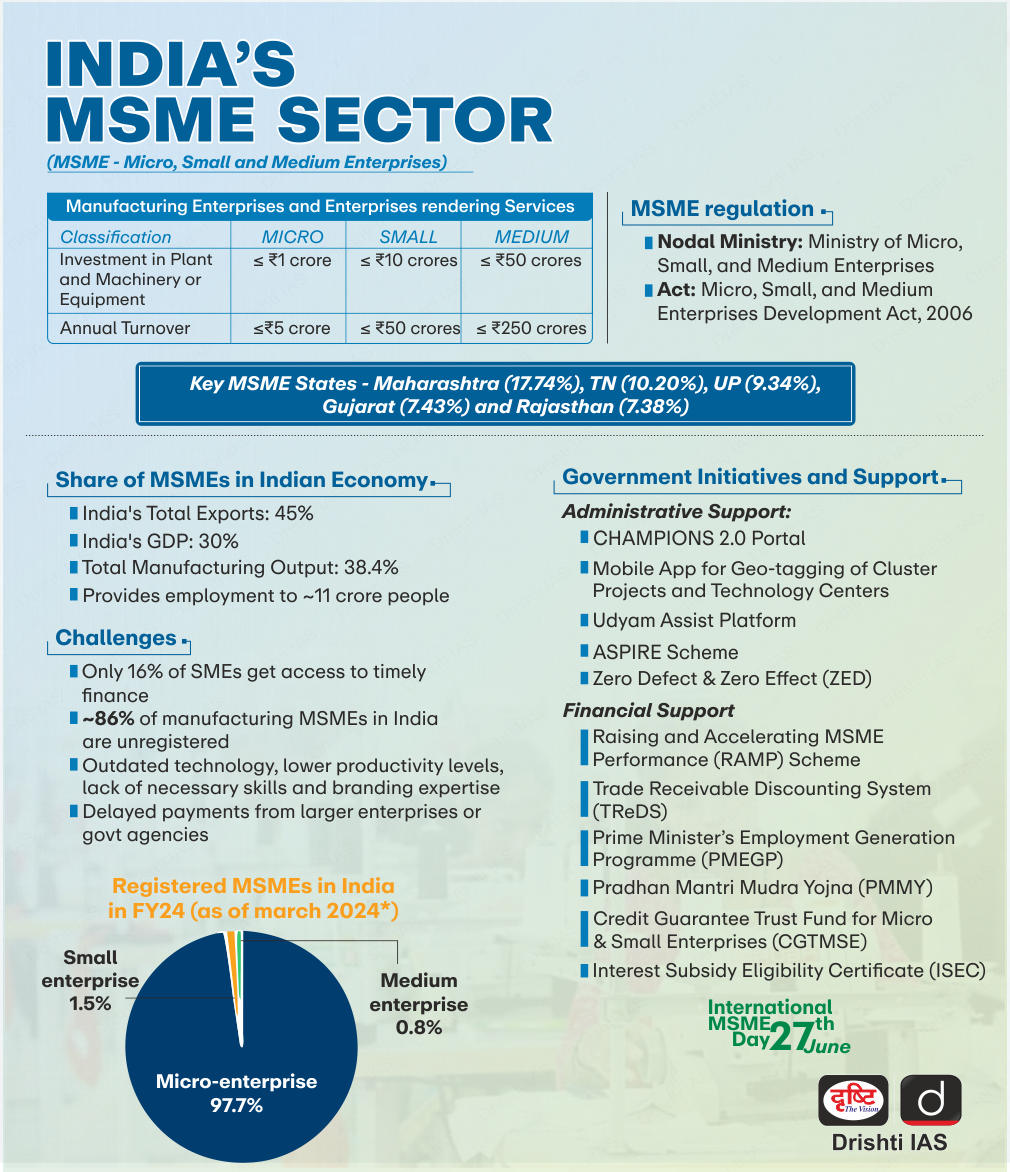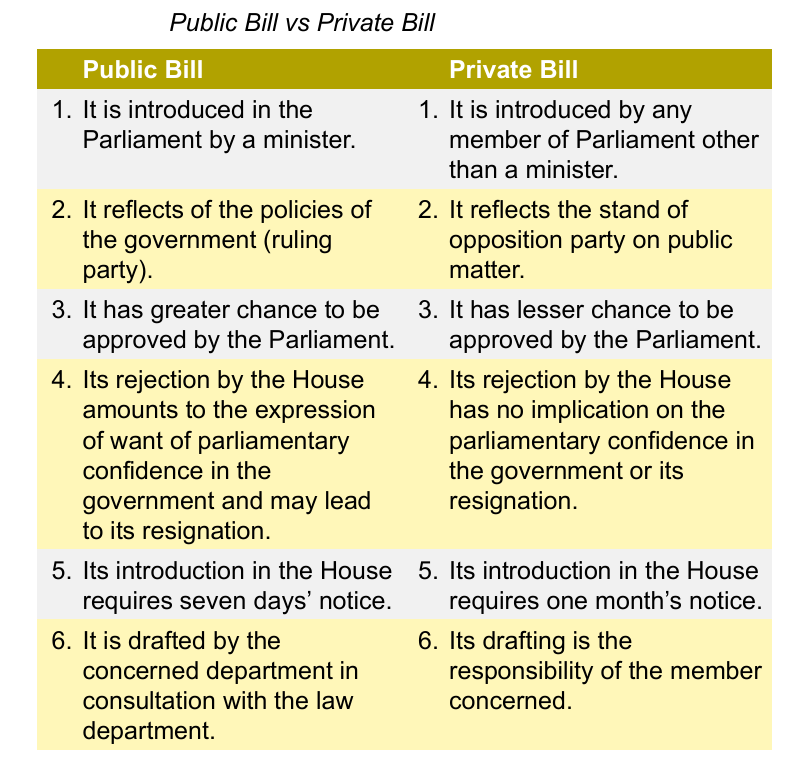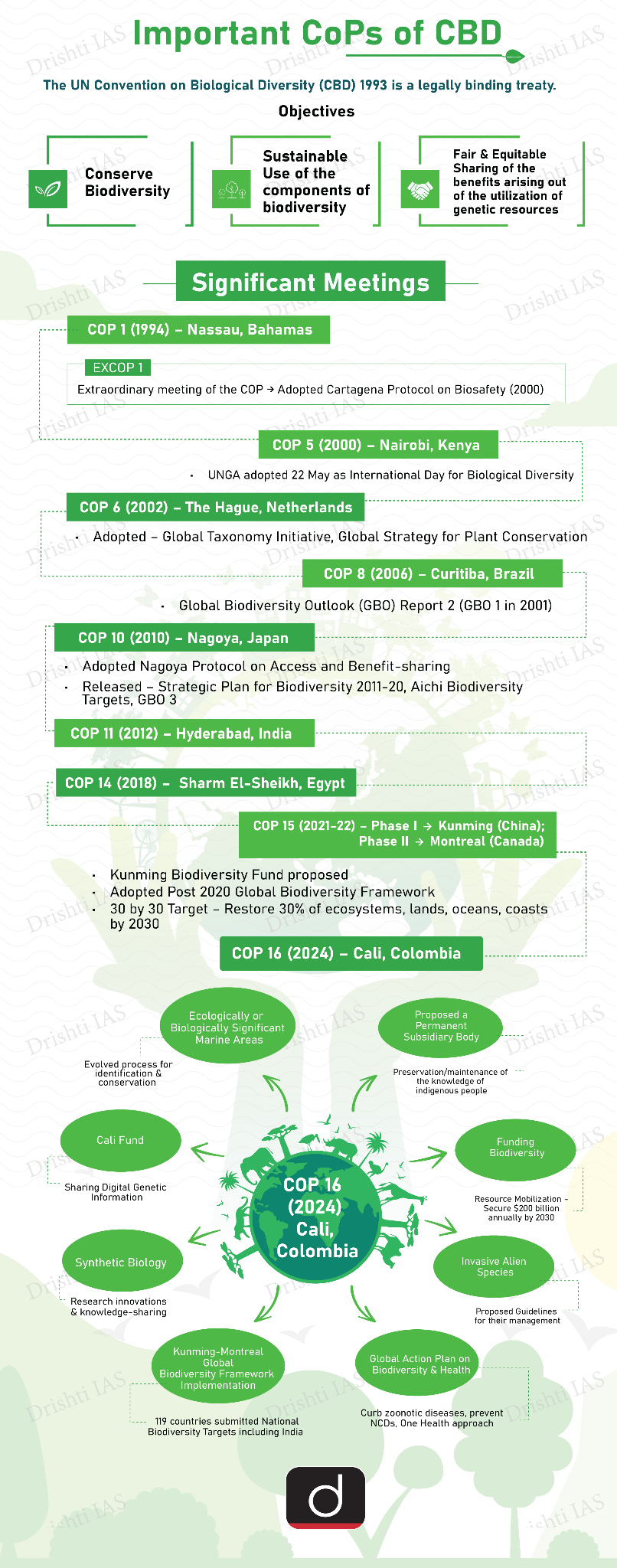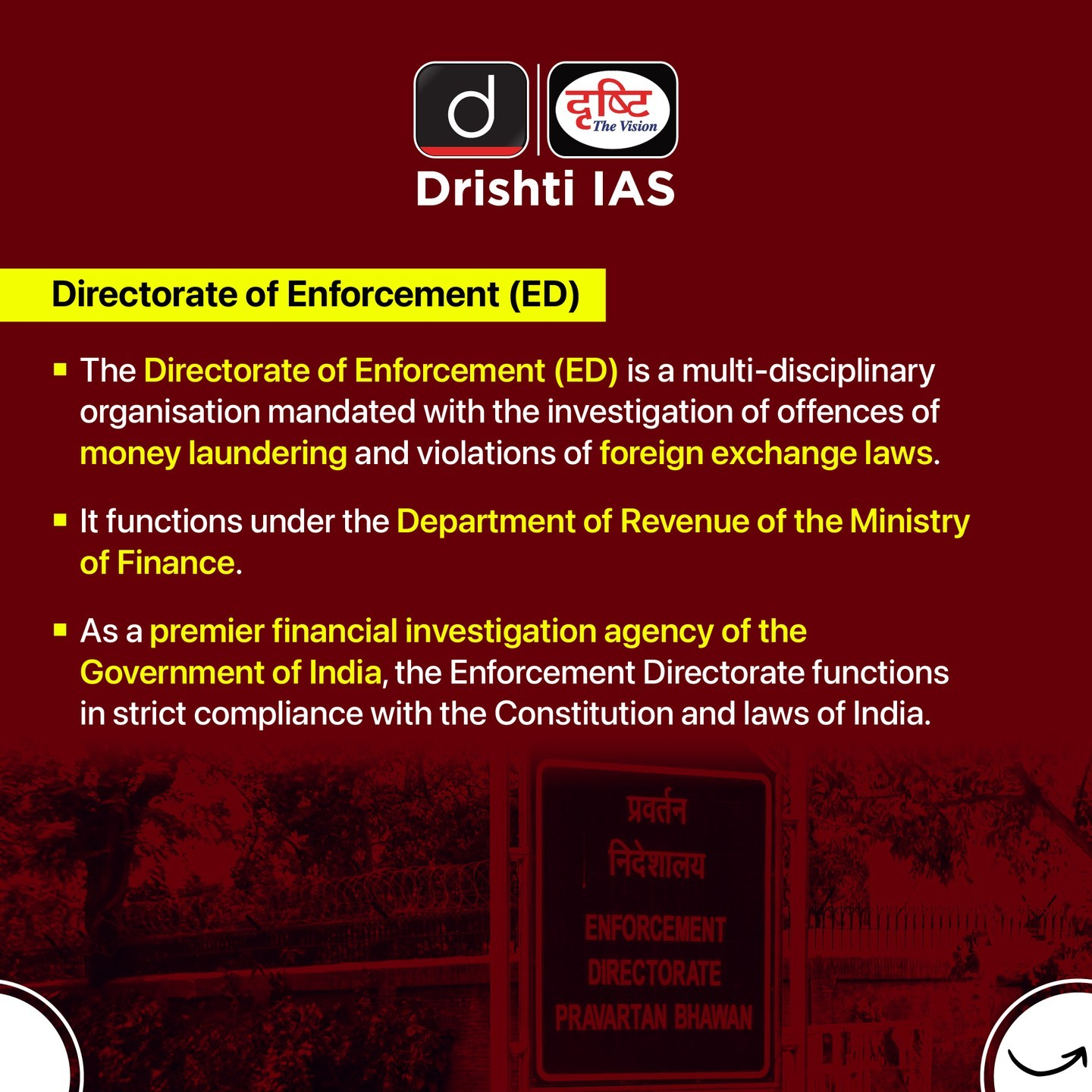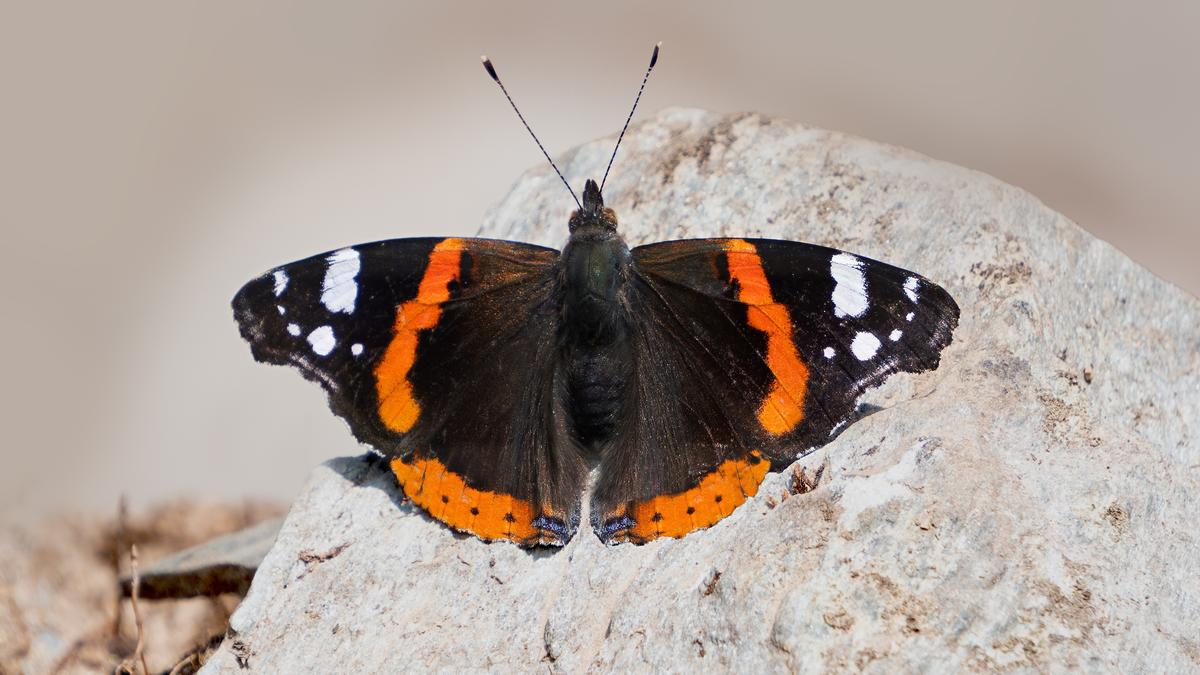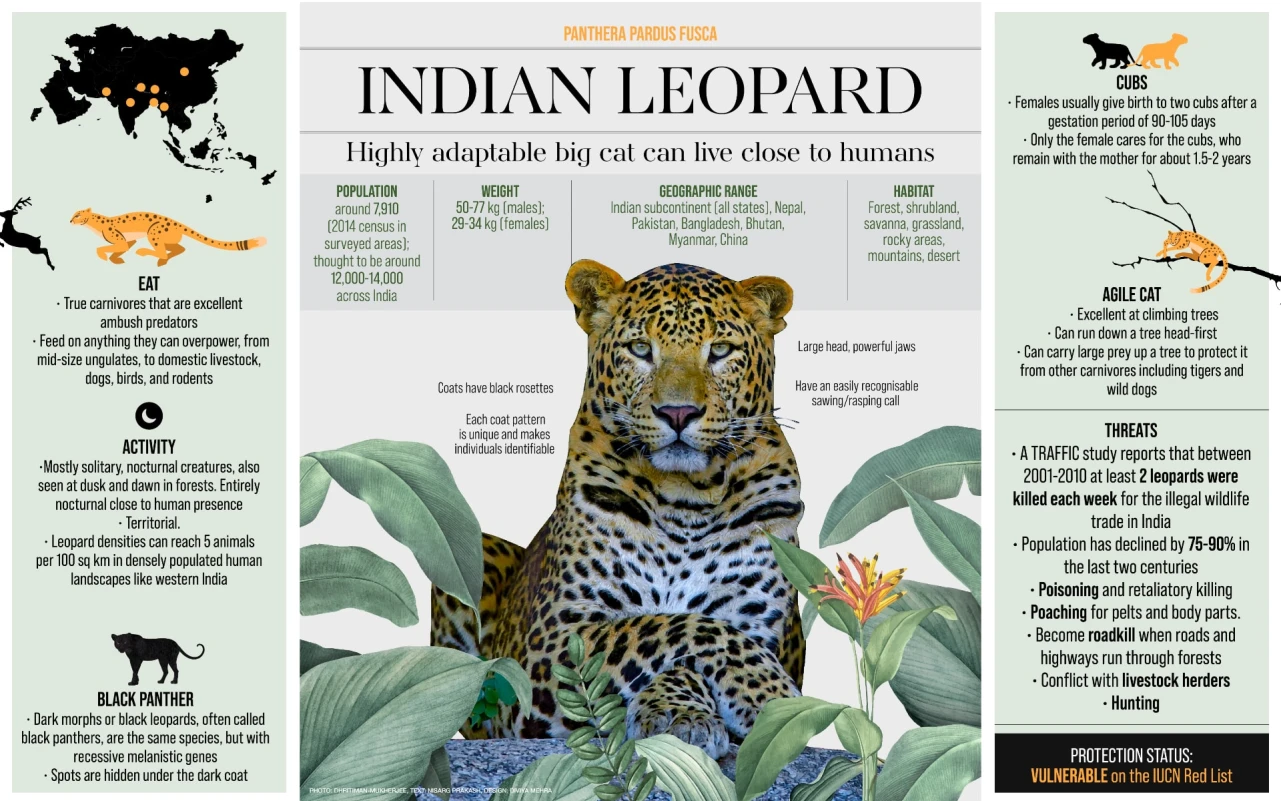NITI Aayog Report on MSMEs in India
For Prelims: NITI Aayog, Micro, Small, and Medium Enterprises, International MSME Day, Ministry of Micro, Small and Medium Enterprises, Manufacturing Sector, Mudra Yojana expansion, Udyam portal, Government e-Marketplace, Production-Linked Incentive, Digital MSME 2.0
For Mains: Role of MSMEs in Rural development, Role of MSMEs in India’s Economic Growth, Key Issues Hindering the Growth of MSME Sector.
Why in News?
NITI Aayog, in collaboration with the Institute for Competitiveness, released a comprehensive report identifying key challenges hindering MSME growth and proposing strategic reforms to enhance their competitiveness and economic impact.
What are MSMEs?
- About:
- Micro, Small, and Medium Enterprises (MSMEs) are businesses categorized based on their investment in plant & machinery or equipment and annual turnover.
- They play a crucial role in India's economic structure by promoting entrepreneurship, generating employment, and supporting industrialization in rural and semi-urban areas.
- Classification of MSMEs:
What Role do MSMEs Play in Driving India’s Economic Growth?
- Contribution to GDP and Employment: MSMEs contribute approximately 29.2% to India’s Gross Domestic Product (GDP), 36.2% to manufacturing output, and employing over 120 million people.
- For example, the textile industry, largely driven by MSMEs, employs millions in activities like spinning, weaving, and apparel manufacturing.
- Export Promotion: MSMEs contribute nearly 45% (FY 2021–22) of India’s total exports, strengthening India’s position in the global trade arena.
- The Indian handicraft sector, largely of small-scale enterprises, contributes significantly to export revenue, accounting for around 40% of global handmade carpet exports.
- Rural Industrialization: MSMEs promote rural industrialization and foster inclusive growth, aligning with Dr. APJ Abdul Kalam’s PURA (Providing Urban Amenities in Rural Areas) vision.
- For instance, the Khadi and Village Industries Commission (KVIC), consisting mainly of small-scale units, plays a critical role in providing employment and empowering local communities in rural areas, contributing to balanced regional development.
- Innovation and Entrepreneurship: MSME fosters innovation and entrepreneurship, with small businesses often quicker to adapt to changing market dynamics.
- India’s thriving startup ecosystem (the third-largest in the world) is predominantly driven by MSMEs, which have led to innovative solutions in sectors like e-commerce, fintech, and other emerging industries.
- Supporting Women Empowerment: MSMEs act as a catalyst for empowering women and marginalized communities by fostering inclusive entrepreneurship.
- According to the Udyam Registration Portal, over 20% of MSMEs are women-owned, highlighting the growing participation of women in the entrepreneurial ecosystem.
| Click Here to Read More: Significance of the MSME Sector in the Indian Economy |
What are the Key Challenges Faced by MSMEs in India?
As per the NITI Ayog’s Report on MSMEs:
- High Informatization: Over 90% of MSMEs in India remain informal, with only 9% of registered firms having transitioned from unregistered status.
- Despite efforts like the Udyam portal (95 lakh registrations vs 6.34 crore total MSMEs), high compliance costs and regulatory burdens deter many from formalising, limiting access to credit, schemes, and global value chains.
- Lack of Formal Credit Access:Despite improvements in credit access for MSMEs rising from 14% to 20% for micro/small and 4% to 9% for medium enterprises (2020–2024), a significant credit gap persists.
- Only 19% of credit demand was met by formal channels in FY21 with other challenges like lack of collateral, high NPAs, weak credit checks, and poor financial literacy, forcing many MSMEs to rely on informal credit at high interest rates (30–60%).
- Skill Gaps: From 2014-2022, skilled labor increased by 19.94% in small, 20% in medium, and 12.72% in large enterprises (World Bank).
- However, a significant skill mismatch exists, with a 3.9% decline in knowledge-intensive hiring.
- Product Diversification Challenges: MSMEs in India face barriers to product diversification due to limited market awareness, technical knowledge, and high costs for machinery and marketing.
- Despite 18% growth in customer base for diversified firms, challenges like high development costs, poor marketing, and limited access to finance hinder brand establishment and entry into international markets.
- Compliance Burden : Tax and other compliances remains a significant challenge for MSMEs in India.
- While GST has improved efficiency, it has also raised compliance costs and operational challenges for MSMEs.
- Inadequate Infrastructure & Outdated Technology: Despite India’s 40th rank in the 2023 Global Innovation Index, MSMEs face limited access to advanced technology, high costs, and unreliable infrastructure, restricting their scalability and integration into global value chains.
- Only 6% of MSMEs use e-commerce and just 45% have adopted AI, reflecting the sector’s slow pace of digital adoption.
- The "Missing Middle" Problem: Despite initiatives like ECLGS (Emergency Credit Line Guarantee Scheme) and Startup India, MSMEs in India struggle to access and fully utilize government schemes due to limited awareness and understanding.
- It reflects the underrepresentation of medium-sized enterprises, with 97.92% of MSMEs classified as micro, 1.89% classified as small and only 0.01% as medium.
- This gap is caused by strict regulations, high compliance costs, limited finance access, and low productivity.
- It reflects the underrepresentation of medium-sized enterprises, with 97.92% of MSMEs classified as micro, 1.89% classified as small and only 0.01% as medium.
What are the Key Recommendations by NITI Aayog on MSMEs?
- Reforming MSME Credit Access: To bridge the credit gap in MSMEs, it is essential to reform the Credit Guarantee Fund Trust for Micro and Small Enterprises (CGTMSE) by enhancing oversight and reducing risk premiums.
- NBFCs, especially in remote areas, should be scaled up with SIDBI funding to improve their capacity and governance.
- At the state level, lowering eligibility barriers for capital and interest subsidies will further support MSMEs at various stages of their growth.
- Skilling and Workforce Alignment: Invest in STEM education to meet MSME manpower needs, particularly in rural areas.
- Align training programs with industry demands and reform vocational education to address the skills gap, focusing on financial literacy and operational skills.
- States should offer partial subsidies for training, with curricula updated regularly to ensure relevance.
- Driving Tech & AI Adoption: Enhance MSME supply chains with digital risk management and tailored insurance products.
- Promote Artificial Intelligence (AI) adoption through subsidies, grants, and awareness campaigns.
- Support technological upgrades in textiles and chemicals, and develop affordable MSME-specific infrastructure. Invest in Industry 4.0 technologies to address obsolescence.
- Upgrading Innovation Ecosystem: Strengthen Institute for Collaborations (IFCs) to foster research, innovation, and technology upgrades for MSMEs by expanding knowledge networks between universities, research institutes, private entities, and government bodies.
- Upgrading Common Facilitation Centres (CFCs) to IFC standards will boost productivity, innovation, and competitiveness in the MSME sector.
- BoostingMarket Access and Supply Chain Management: MSMEs should receive export incentives and digital platform support, similar to initiatives in Haryana, Bihar, Andhra Pradesh, and Tamil Nadu, including quality certifications and market research.
- Collaboration with design schools and investment in new technologies will enhance competitiveness in sectors like textiles.
- States should invest in supply chain infrastructure and local training. Additionally, promoting food processing MSMEs through trade fairs and export programs will improve market access.
- Improving Policy Monitoring & Engagement: Enhance MSME policy awareness and outreach at the state level. Regular surveys should assess policy performance and drive improvements.
- Engage effectively with MSME stakeholders, including Owner-Operated Enterprises (OAEs) (where the owner is directly involved in the day-to-day operations) and women-owned enterprises.
- Capture informal sector MSMEs in datasets to reduce informality and identify areas for improvement.
More About MSME Sector in IndiaClick Here to Read: Key Issues Associated with MSME Sector in India, Measures to Enhance the Effectiveness of MSME in India |
What are the Key Government Initiatives for MSMEs?
- Pradhan Mantri MUDRA Yojana
- Mutual Credit Guarantee Scheme for MSMEs
- Udyam Registration
- CHAMPIONS Portal
- MSME SAMADHAAN
- Government e-Marketplace (GeM), an online platform for MSMEs to participate in public procurement, expanding their market access.
Conclusion
MSMEs are crucial to India's economic growth but face challenges due to inadequate data. Leveraging existing data sources like PLFS and improving platforms like UDYAM will help formulate better policies, enhance MSME competitiveness, and support their integration into global value chains, driving sustainable economic development.
|
Drishti Mains Question Prioritising the development of the Micro, Small and Medium Enterprises (MSMEs) sector is critical to the future of the country. Critically analyse. |
UPSC Civil Services Examination, Previous Year Question:(PYQ)
Prelims:
Q.1 What is/are the recent policy initiative(s)of Government of India to promote the growth of the manufacturing sector? (2012)
- Setting up of National Investment and Manufacturing Zones
- Providing the benefit of ‘single window clearance’
- Establishing the Technology Acquisition and Development Fund
Select the correct answer using the codes given below:
(a) 1 only
(b) 2 and 3 only
(c) 1 and 3 only
(d) 1, 2 and 3
Ans: (d)
Q2. Which of the following can aid in furthering the Government’s objective of inclusive growth? (2011)
- Promoting Self-Help Groups
- Promoting Micro, Small and Medium Enterprises
- Implementing the Right to Education Act
Select the correct answer using the codes given below:
(a) 1 only
(b) 1 and 2 only
(c) 2 and 3 only
(d) 1, 2 and 3
Ans: (d)
Q3. Consider the following statements with reference to India : (2023)
- According to the Micro, Small and Medium Enterprises Development (MSMED) Act, 2006, the ‘medium enterprises’ are those with investments in plant and machinery between `15 crore and `25 crore.
- All bank loans to the Micro, Small and Medium Enterprises qualify under the priority sector.
Which of the statements given above is/are correct?
(a) 1 only
(b) 2 only
(c) Both 1 and 2
(d) Neither 1 nor 2
Ans: (b)
Mains:
Q.1 “Industrial growth rate has lagged behind in the overall growth of Gross-Domestic-Product(GDP) in the post-reform period” Give reasons. How far are the recent changes in Industrial Policy capable of increasing the industrial growth rate? (2017)
Q.2 Normally countries shift from agriculture to industry and then later to services, but India shifted directly from agriculture to services. What are the reasons for the huge growth of services vis-a-vis the industry in the country? Can India become a developed country without a strong industrial base? (2014)
Reviving Private Members’ Bills
For Prelims: Private Member’s Bills, Members of Parliament, Anti-Defection Law, Zero Hour, Question Hour
For Mains: Role and significance of Private Members’ Bills in Indian democracy, Institutional reforms to strengthen Parliament as a deliberative body
Why in News?
The Vice President of India recently described Private Member’s Bills (PMBs) as “far-sighted, forward-looking, and a gold mine” for India’s democracy.
- His remarks have renewed focus on the declining relevance of PMBs, which are increasingly sidelined in Parliament despite their potential to strengthen individual legislative initiative.
What are Private Member’s Bills?
- About: PMBs are legislative proposals introduced by Members of Parliament (MPs) who are not Ministers (i.e., not part of the government), enabling them to raise issues and suggest laws or amendments on matters significant to their constituencies.
- Key Features: Only non-government MPs can introduce these bills, offering a chance for independent legislative proposals.
- MPs can also introduce resolutions to call attention to specific matters.
- Procedure:
- Drafting and Notice: MPs draft and submit bills with at least one month's notice.
- Introduction: Bills are introduced in Parliament, followed by initial discussions.
- Debate: If selected, bills are debated, typically in limited Friday afternoon sessions.
- Decision: Bills may be withdrawn or proceed to a vote.
- Decline of PMBs: Since Independence, only 14 PMBs have been passed by both Houses and received Presidential assent. No PMB has passed both Houses since 1970.
- During the 17th Lok Sabha (2019–2024), 729 PMBs were introduced in the Lok Sabha and 705 in the Rajya Sabha, but only 2 and 14 were discussed in each House respectively.
- In the 18th Lok Sabha (as of May 2025), 64 PMBs were introduced, but none discussed. In Rajya Sabha, 49 out of 82 PMBs were introduced, with only one discussed.
How do Private Member’s Bills Empower Legislative Democracy in India?
- Promoting Independent Thought and Legislative Innovation: PMBs allow MPs, regardless of party, to raise issues outside the government's agenda, fostering innovation in legislative discourse.
- The ‘Right to Disconnect’ Bill (2019), introduced to propose a legal right for employees to disconnect from work after working hours.
- While not passed, it sparked national debate on work-life balance and mental health, highlighting how PMBs can address societal issues often overlooked by government legislation.
- The ‘Right to Disconnect’ Bill (2019), introduced to propose a legal right for employees to disconnect from work after working hours.
- Driving Social Change: The ‘Rights of Transgender Persons’ Bill (2014) was the first PMB in 40 years passed in the Rajya Sabha.
- Though it didn’t pass the Lok Sabha, it paved the way for the Transgender Persons (Protection of Rights) Act, 2019, driving inclusivity and social justice.
- Improving Governance: The first Private Member’s Bill passed by Parliament was the Muslim Wakfs Bill, 1952, which aimed to improve the governance and administration of Wakf properties.
- It led to the enactment of the Waqf Act, 1954, which was later amended as the Waqf (Amendment) Act, 2025.
- PMBs as Catalysts for National Debate: In 1966, after Lal Bahadur Shastri’s death, H.V. Kamath, introduced a PMB to amend the Constitution, making only Lok Sabha members eligible for the Prime Minister's post.
- This Bill sparked an important political discussion on the role of the Prime Minister and the balance of power between the Lok Sabha and Rajya Sabha.
What are the Challenges Undermining the Relevance of Private Member’s Bills?
- Lack of Time and Attention: Data from PRS Legislative Research shows the 17th Lok Sabha allocated only 9.08 hours to PMBs, while the Rajya Sabha spent 27.01 hours, a small fraction of total session hours.
- Friday scheduling of Private Members' business limits discussion, as many MPs leave for constituencies, and sessions are often overridden by disruptions or urgent government business.
- The decline of these bills can also be attributed to MPs' lack of seriousness, with many skipping discussions.
- Structural Constraints: The lack of a dedicated parliamentary mechanism, such as a review committee, hinders the scrutiny, prioritization, and timely discussion of PMBs, leading to legislative inefficiency.
- The Anti-Defection Law (the Constitutional 52nd Amendment Act, 1985) limits MPs' independence if party discipline overrides individual initiative, making it difficult for MPs to introduce bills that deviate from their party's agenda.
- Low Legislative Conversion: Minimal PMBs reach the stage of debate or voting, reducing the incentive for MPs to engage with the process seriously.
What Reforms can Revitalize the Private Member’s Bills Mechanism in India?
- Protect Time Reserved for PMBs: Amend the Rules of Procedure and Conduct of Business to safeguard the Friday slot for PMBs. This time should only be overridden in cases of national emergency.
- Enforce this schedule consistently to enable proper debate and passage of PMBs.
- Additionally, rather than encroaching on time reserved for PMBs, the government should extend parliamentary working hours; even a modest 1–2 hour extension can enhance the efficiency of Zero Hour and Question Hour while preserving PMB discussions.
- This reform is especially crucial with the impending delimitation, which is expected to increase the number of MPs.
- Institutional and Operational Reforms: Establish a PMB Review Committee to vet proposals for constitutional validity, societal relevance, and bipartisan support.
- Create a fast-track process for high-impact PMBs with substantial public and parliamentary backing.
- Time and Format Innovations: Slightly extend parliamentary working hours to accommodate government and private business distinctly.
- Introduce the UK-style Ten-Minute Rule, allowing MPs to briefly present PMBs and opposing views within a fixed time, enhancing efficiency.
- Encouraging Political Engagement: Promote awareness and encourage both ruling and opposition MPs to view PMBs as tools for advocacy and grassroots responsiveness. Boost visibility through Parliament TV, bulletins, and public consultations.
|
Drishti Mains Question: Despite their limited success in becoming law, Private Members’ Bills are vital for democratic vibrancy in Parliament. Discuss |
UPSC Civil Services Examination, Previous Year Questions (PYQs)
Prelims
Q. With reference to the Parliament of India, consider the following statements: (2017)
- A private member’s bill is a bill presented by a Member of Parliament who is not elected but only nominated by the President of India.
- Recently, a private member’s bill has been passed in the Parliament of India for the first time in its history.
Which of the statements given above is/are correct?
(a) 1 only
(b) 2 only
(c) Both 1 and 2
(d) Neither 1 nor 2
Ans: (d)
Exp:
- The process of law making begins with the introduction of a Bill in either House of the Parliament. A Bill can be introduced either by a Minister or a member other than a Minister. In the former case, it is called a Government Bill and in the latter case, it is known as a Private Member’s Bill.
- In other words, a Private Member’s Bill is introduced by any member (elected or nominated) of Parliament other than a minister. One month’s notice period is required prior to its introduction. Its drafting is the sole responsibility of the member who introduces the bill. Hence, statement 1 is not correct.
- The first Private Member’s Bill passed by parliament was the Muslim Wakfs Bill, 1952, which aimed at providing better governance and administration of Wakfs. It was passed in 1954. Hence, statement 2 is not correct.
- The Rights of Transgender Persons Bill, 2014, passed by the Rajya Sabha in 2015 became the first private member’s bill to get the Rajya Sabha’s approval in the last 45 years. Therefore, option (d) is the correct answer.
Satavahana Dynasty and Culture
For Prelims: Archaeological Survey of India (ASI), Inscriptions, Gautamiputra Satakarni, Mahayana Buddhism, Karle Chaitya, Nasik Viharas, Amaravati Stupa, Coins.
For Mains: Contribution of Satavahana dynasty in polity, economy, inscriptions, religious patronage, and cultural sphere.
Why in News?
The Archaeological Survey of India (ASI) has documented 11 ancient inscriptions in Peddapalli, Telangana belonging to the Satavahana dynasty.
- Written in Brahmi script and Prakrit language, these 1st BCE–6th CE inscriptions offer key insights into the Satavahana era and early Deccan politics and culture.
- The inscriptions confirm Telangana as part of Asmaka, one of the sixteen Mahājanapadas, highlighting its historic role and early ties to major dynasties.
What are the Key Facts Regarding the Satavahana Dynasty?
- About: The Satavahanas (1st century BC to the early 3rd century AD) succeeded the Mauryas in the Deccan and central India, with early rule centered in north Maharashtra (upper Godavari valley) and later expanding to Karnataka and Andhra.
- They are identified with the Andhras mentioned in the Puranas, though inscriptions do not use this name.
- Important Rulers:
|
Ruler |
Reign Period |
Key Achievements |
|
Simuka |
60 BC- 37 BC |
Founder of the Satavahana dynasty and is mentioned as the first king in a list of royals in a Satavahana at Naneghat inscription. |
|
Gautamiputra Satakarni |
AD 106–130 |
Regarded as the greatest Satavahana ruler. |
|
Defeated the Shakas and destroyed the Kshaharata lineage (ruled by Nahapana). |
||
|
The empire extended from Malwa in the north to Karnataka in the south. |
||
|
Coins of Nahapana (Kshaharata ruler) were re-struck by Gautamiputra, symbolizing conquest. |
||
|
Vashishthiputra Pulumayi |
AD 130–154 |
Shifted capital to Paithan (Pratishthan) on the Godavari. |
|
Brought Andhra into the Satavahana fold. |
||
|
Yajna Sri Satakarni |
AD 165–194 |
Regained lost territories in north Konkan and Malwa. |
|
Patron of trade and navigation; his coins depict ships. |
||
|
His reign marked the peak of maritime trade. |
- Material Culture: Iron tools like hoes, ploughshares, and arrowheads were widespread, with smelting sites in Karimnagar and Warangal.
- Agriculture: Iron tools and paddy transplantation boosted farming, making the Krishna-Godavari delta a major rice region.
- Cotton production, noted by Pliny (author of Natural History), was a hallmark of Andhra.
- Urbanisation and Trade: Peddabankur (200 BCE–200 CE) featured brick structures, wells, and covered underground drainage. Pliny noted 30 walled towns in the eastern Deccan (Andhra region).
- The surge in trade is reflected in the spread of Roman and Satavahana coins in the Krishna-Godavari region.
- Coins: Coins featured Prakrit inscriptions and symbols like ships with two masts, elephants (strength), lions (power), star pattern, Chaitya, and Dharmachakra.
- Coins were issued in lead, potin (a mixture of copper, lead, and tin), copper, and bronze, while gold was used as bullion.
- Social Organization: The Satavahanas, originally a Deccan tribe, became brahmanized, with Gautamiputra Satakarni re-establishing the varna system disrupted by Shakas.
- The Satavahana dynasty showed matrilineal influence, with kings named after their mothers, but it remained patriarchal, with succession passing to the male heir.
- Craft and commerce flourished, with merchants, and artisans, especially gandhikas (perfumers) donating to Buddhist causes.
- Administration: The 3-tier feudal system consisted of the Raja (King), who could issue coins, the Mahabhoja (second-rank rulers), and the Senapati (military chiefs with local authority).
- Districts (Ahara or Rashtra) governed by Mahamatras (officials).
- Military-based governance:
- Senapati (commander) acted as provincial governor.
- Gaulmika (military officer) maintained rural law and order.
- Military camps (Kataka, Skandhavara) served as administrative centers.
- The Roman historian Pliny noted that the Andhra kingdom (Satavahanas) had a large army with infantry, cavalry, and elephants, reflecting their military strength.
- Religion: The Satavahana rulers, as Brahmanas, promoted Brahmanism, performing Vedic sacrifices like ashvamedha and vajapeya, and worshipping Vaishnava gods such as Krishna and Vasudeva.
- The Satavahanas supported Buddhism, granting land to monks in Nagarjunakonda and Amaravati, where Mahayana Buddhism thrived.
- The Satavahanas were the first to grant land to Brahmanas, but they granted land more often to Buddhist monks.
- Architecture: The Satavahanas are known for their rock-cut architecture, with notable examples like the Karle Chaitya and Nasik Viharas.
- The Amaravati Stupa was reconstructed during the Satavahana period, featuring intricate sculptures of the Buddha's life.
- The Satavahanas patronised Buddhist art and architecture, as seen in the Ajanta Caves 9 and 10, and actively promoted the Amravati School of Art, known for its intricate and narrative sculptures.
- Inscriptions from Naneghat in Maharashtra highlight the dynasty’s religious patronage, particularly towards Buddhism, mentioning tax exemptions on lands granted to Buddhist monks.
- Nagarjunakonda prospered most in the second–third centuries under the patronage of the Ikshvakus, the successors of the Satavahanas.
- Language: The official language of the Satavahanas was Prakrit, and their inscriptions were written in the Brahmi script.
- Gathasattasai (Gathasaptasati), a Prakrit text attributed to King Hala, is an important literary work from this period, containing 700 verses.
- Decline: The dynasty declined around the 3rd century AD, and was succeeded by the Ikshvakus in eastern Deccan, who continued several Satavahana traditions, especially in Buddhist patronage.
- Later, the Pallavas rose to prominence in the southern region.
Conclusion
The discovery of Satavahana inscriptions in Telangana provides valuable insights into the dynasty’s political, religious, and cultural impact. The Satavahanas, renowned for their military strength, support for Buddhism, and matrilineal influences, significantly contributed to the development of trade, urbanization, and the shaping of early Deccan history. After their decline, the Ikshvakus emerged as their successors in the eastern Deccan, continuing many of their administrative and cultural traditions, especially the patronage of Buddhism.
|
Drishti Mains Question: Q. Examine the socio-political structure of the Satavahana dynasty, focusing on their administration, military system, and feudal relationships. |
UPSC Civil Services Examination, Previous Year Questions (PYQs)
Prelims
Q. Who among the following rulers advised his subjects through this inscription? (2020)
“Whosoever praises his religious sect or blames other sects out of excessive devotion to his own sect, with the view of glorifying his own sect, he rather injures his own sect very severely.”
(a) Ashoka
(b) Samudragupta
(c) Harshavardhana
(d) Krishanadeva Raya
Ans: (a)
Q. In which of the following relief sculpture inscriptions is ‘Ranyo Ashoka’ (King Ashoka) mentioned along with the stone portrait of Ashoka? (2019)
(a) Kanganahalli
(b) Sanchi
(c) Shahbazgarhi
(d) Sohgaura
Ans: (a)
Mains
Q. Discuss the Tandava dance as recorded in the early Indian inscriptions. (2013)
Biological Diversity (Access and Benefit Sharing) Regulation, 2025
Why in News?
The National Biodiversity Authority (NBA) notified the Biological Diversity (Access to biological Resources and Knowledge Associated thereto and Fair and Equitable Sharing of Benefits) Regulation 2025 to ensure fair benefit sharing from the use of biological resources.
What are the Key Highlights of the Biological Diversity (Access and Benefit Sharing) Regulation, 2025?
- Benefit Sharing Linked to Turnover: All users who have an annual turnover of over Rs 1 crore need to share a statement with information on the resources used per year.
|
Annual Turnover |
Benefit Sharing Rate |
|
Up to Rs 5 crore |
Exempt |
|
Rs 5 – Rs 50 crore |
0.2% |
|
Rs 50 – Rs 250 crore |
0.4% |
|
Above Rs 250 crore |
0.6% |
- High-Value Biological Resources: For high-value biological resources like red sanders, sandalwood, agarwood, and threatened species under the Biodiversity Act, 2002 benefit sharing must be at least 5% of the sale or auction amount, and can exceed 20% for commercial use.
- Digital Sequence Information (DSI): The 2025 Regulation replaces the 2014 Guidelines, expanding the scope to include DSI, which can now be considered part of genetic resources, unlike the earlier framework.
- DSI refers to the digital representation of genetic sequences derived from Deoxyribonucleic acid (DNA), Ribonucleic acid (RNA), or proteins of organisms. It's essentially the digital code of an organism's genetic makeup.
- Researchers & IP Applicants: The Regulation mandates benefit-sharing for researchers and intellectual property applicants, with 10-15% of the collected benefits retained by the NBA.
- Cultivated Medicinal Plants Exempt: Cultivated medicinal plants are exempt from benefit sharing.
- This exemption stems from the Biological Diversity (Amendment) Act 2023, which promoted medicinal plant cultivation and eased compliance for AYUSH practitioners.
What is Access and Benefit Sharing?
- About: ABS refers to the process of granting access to biological resources (such as plants, animals, or genetic material) and ensuring that the benefits arising from their use whether monetary or non-monetary are equitably shared with the source communities or nations.
- ABS relies on prior informed consent (PIC) from the provider and negotiations to establish mutually agreed terms (MAT) for the fair and equitable sharing of genetic resources and associated benefits.
- Framework: Rooted in the Convention on Biological Diversity (CBD). The Nagoya Protocol, adopted in 2010 under the CBD, provides a legally binding framework for access to genetic resources and fair benefit-sharing.
- COP-16 of the CBD (2024), held in Cali, Colombia, finalized key modalities for a multilateral mechanism to share benefits from the use of DSI.
- In India ABS is implemented through the Biological Diversity Act, 2002) and ABS Regulation, 2025.
National Biodiversity Authority
- The NBA, established in 2003 under the Biological Diversity Act, 2002, is a statutory body that advises the Centre on biodiversity conservation, sustainable use, and fair benefit-sharing.
- Headquartered in Chennai, It operates through a decentralized structure involving State Biodiversity Boards (SBBs) and local Biodiversity Management Committees (BMCs).
- While SBBs guide state governments and regulate commercial use, BMCs focus on local biodiversity documentation and conservation.
- BMCs are responsible for preparing People's Biodiversity Registers (PBRs).
- Since its establishment, NBA has supported creation of SBBs in 28 States, 8 UT's and facilitated establishment of around 2,77,688 BMCs.
UPSC Civil Services Examination Previous Year Question (PYQ)
Q. Consider the following statements: (2023)
- In India, the Biodiversity Management Committees are key to the realization of the objectives of the Nagoya Protocol.
- The Biodiversity Management Committees have important functions in determining access and benefit sharing, including the power to levy collection fees on the access of biological resources within its jurisdiction.
Which of the statements given above is/are correct?
(a) 1 only
(b) 2 only
(c) Both 1 and 2
(d) Neither 1 nor 2
Ans: (c)
Exp:
- Biodiversity Governance in India: India’s Biological Diversity Act 2002 (BD Act), is in close synergy with the Nagoya Protocol and aims to implement provisions of the Convention on Biological Diversity (CBD).
- The Nagoya Protocol sought to ensure commercial and research utilisation of genetic resources led to sharing its benefits with the government and the community that conserved such resources.
- Under Section 41(1) of the Biological Diversity Act, 2002, every local body in the State shall constitute a Biodiversity Management Committee within its area of jurisdiction. Hence, statement 1 is correct.
- The main function of the BMC is to prepare People’s Biodiversity Register (PBR) in consultation with local people. The BMC shall be responsible for ensuring the protection of the knowledge recorded in PBR, especially to regulate its access to outside persons and agencies.
- In addition to preparation of the People’s Biodiversity Register (PBR), the BMCs in their respective jurisdiction shall also be responsible for the following :-
- Conservation, sustainable use and access and benefit sharing of biological resources.
- Regulation of access to the biological resources and/ or associated Traditional Knowledge, for commercial and research purposes.
Mains
Q. How is the Government of India protecting traditional knowledge of medicine from patenting by pharmaceutical companies? (2019)
Red-Crowned Roofed Turtle
The Red-Crowned Roofed Turtle (Batagur kachuga) has been reintroduced into the Ganga River after 30-years, marking a major success under the Namami Gange Mission and the Turtle Survival Alliance India (TSAFI) project.
- Turtles were released in the Haiderpur Wetland, a Ramsar site located near the Bijnor Ganga Barrage within the Hastinapur Wildlife Sanctuary, Uttar Pradesh.
Red Crowned Roofed Turtle:
- About: It is a freshwater turtle belonging to the family Geoemydidae. Also known as Bengal Roof Turtle, they are one of the 24 species endemic to India.
- Key Characteristics: The females grow up to 56 cm and 25 kg, while males are smaller and exhibit bright red, yellow, white, and blue markings on the face and neck.
- The carapace (upper shell) is strongly keeled, particularly in juveniles and plastron (lower shell) is laterally angulated in younger individuals, giving them a sharp-edged appearance.
- This herbivorous species feeds on aquatic plants and lays 11–30 eggs during March–April.
- Habitat & Distribution: It was historically found in the river systems of India, Nepal, and Bangladesh, particularly in large, deep rivers like the Ganga, Chambal, and Brahmaputra.
- Due to habitat degradation, sand mining, and pollution, it disappeared from the Ganga’s main channel.
- It has now been reintroduced into the Haiderpur Wetland in Uttar Pradesh, India, which connects to the Ganga and offers a suitable environment for its revival.
- Major Threats: Habitat loss due to pollution, dam construction, and water extraction. Sand mining and seasonal agriculture destroy its nesting sandbars, illegal fishing nets cause drowning and poaching and the illegal pet trade.
- Protection Status:
- IUCN Red List : Critically Endangered
- Wildlife Protection Act (WPA), 1972: Schedule I
- CITES : Appendix II
Turtle Survival Alliance India (TSAFI
- TSAFI is the Indian chapter of the global Turtle Survival Alliance (TSA), formed in 2001 under IUCN to protect freshwater turtles and tortoises from threats like habitat loss, illegal trade, and climate change, with the mission of “Zero Turtle Extinctions in the 21st Century.
| Read More: Red Crowned Roofed Turtle, Olive Ridley Turtles in India |
69th Foundation Day of ED
The 69th Foundation Day of the Enforcement Directorate (ED), held in New Delhi, reaffirmed the agency’s pivotal role in combating economic offences and money laundering, as India strives toward the vision of Viksit Bharat 2047.
- ED: Established on 1st May 1956, as the 'Enforcement Unit' under the Department of Economic Affairs to tackle violations of the Foreign Exchange Regulation Act (FERA), 1947, and renamed as the Enforcement Directorate in 1957. Its headquarters is located in New Delhi.
- Transferred to the Department of Revenue in 1960, the ED now functions under the Union Ministry of Finance, enforcing the criminal provisions of the Prevention of Money Laundering Act, 2002 (PMLA) and Fugitive Economic Offenders Act, 2018 (FEOA), and civil provisions of Foreign Exchange Management Act (FEMA).
- The ED is headed by a Director (not below the rank of Additional Secretary, to the Government of India).
- Core functions of ED include curbing money laundering, financing of terrorism, and organised crime, ensuring economic security.
- Achievements of ED: In FY 2024–25, the ED issued provisional attachment orders worth Rs 30,036 crore, reflecting a 44% increase in number and a 141% increase in value over 2023–24.
- As of 2025, the total value of assets under provisional attachment stood at Rs 15.46 lakh crore.
- Between 2014 and 2024, ED initiated around 5,000 new PMLA investigations, showcasing a significant increase in enforcement activities.
| Read more: Enforcement Directorate |
Red Admiral Butterfly
The Red Admiral butterfly (Vanessa atalanta) has been sighted for the first time in India’s Dhauladhar mountain range in Himachal Pradesh.
- Size and Family: The Red Admiral butterfly belongs to the Nymphalidae family and has a wing span ranging from 67-72mm (male to female).
- Morphologically, the Red Admiral resembles the Indian Red Admiral (Vanessa indica) but can be distinguished by its narrower, deeper crimson discal band and the consistent presence of a diagnostic spot in the upper forewing (a feature absent in the Indian species).
- Global Distribution: The Red Admiral butterfly is found in North and South America, Europe, and Asia (no confirmed records from China, Mongolia, or Afghanistan).
- Habitat: Common in urban and disturbed landscapes, but also found in moist forested areas, and wetlands, where it requires water, minerals, and sugars to survive.
- Behavior: Male Red Admirals are highly territorial and often chase rivals from their roosting spots.
- Its larvae feed on stinging nettle (Urtica dioica), found abundantly in the Western Himalayas.
- Climate Adaptation: The species is resilient to climate change due to its diverse host plants, primarily from the nettle family (Urticaceae), but may face challenges from habitat loss and environmental changes affecting plant populations.
| Read more: Butterflies Adaptation and Evolution Processes |
Rise in Leopard Poaching
Poachers are now targeting leopards more often because strict protection laws make tigers harder to hunt, while leopards are easier to find and less protected, making them a common substitute for tiger body parts in the international market.
- According to CITES, around 12,000 leopards and their parts were traded between 2020 and 2023 worldwide.
- Leopards have been eliminated from 75% of their natural habitat across Africa, the Middle East, and Asia due to poaching and habitat destruction.
- Leopards are being poached and mislabeled as tigers in illegal wildlife trade, especially in Asia, to meet demand for traditional medicine, luxury items, and trophies.
- South Africa’s weak laws and captive breeding industry fuel global illegal big cat trade.
- Leopard Population in India (2024):
- Total: 13,874 (1.08% annual growth since 2018).
- Highest population: Madhya Pradesh, followed by Maharashtra, Karnataka, and Tamil Nadu.
- Conservation Status: IUCN Red List (Vulnerable), CITES (Appendix-I) and Wildlife (Protection) Act, 1972 (Schedule-I).
| Read More: Status of Leopards in India 2022 |

